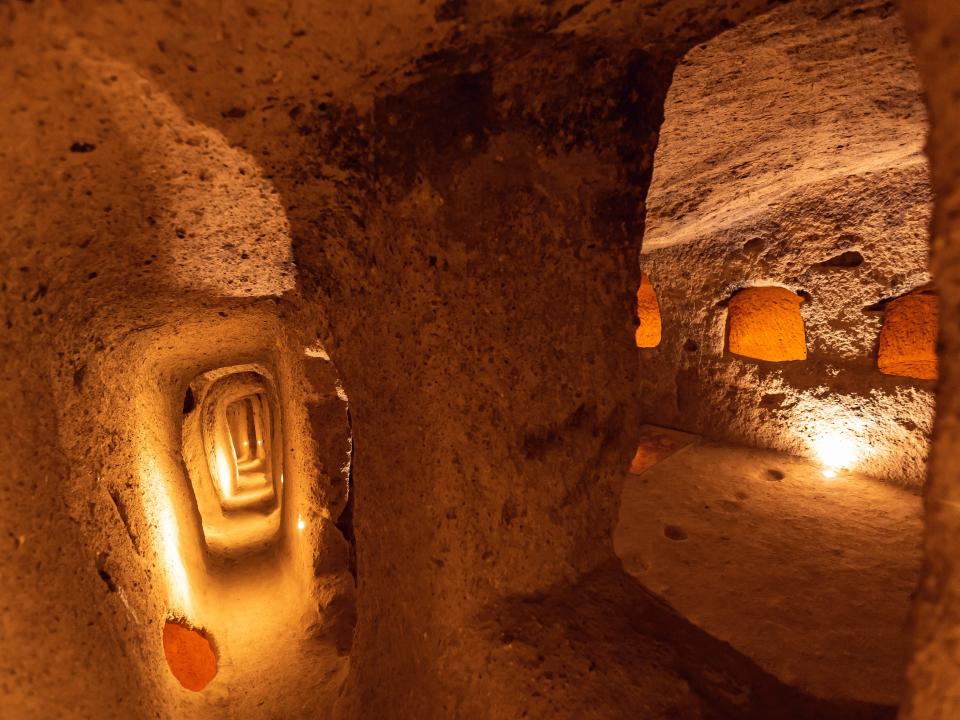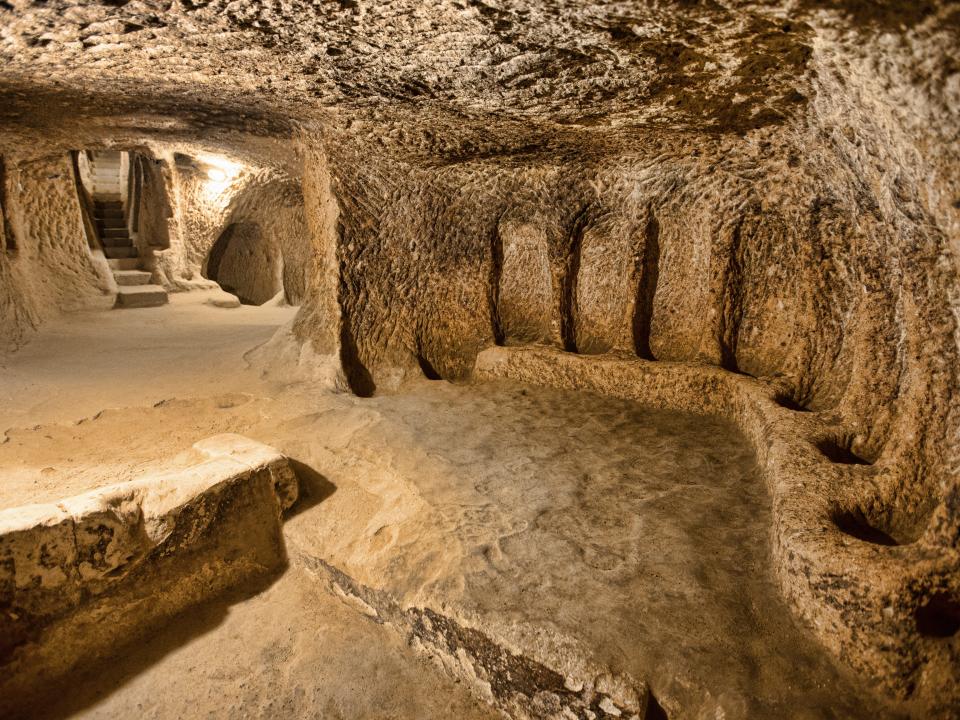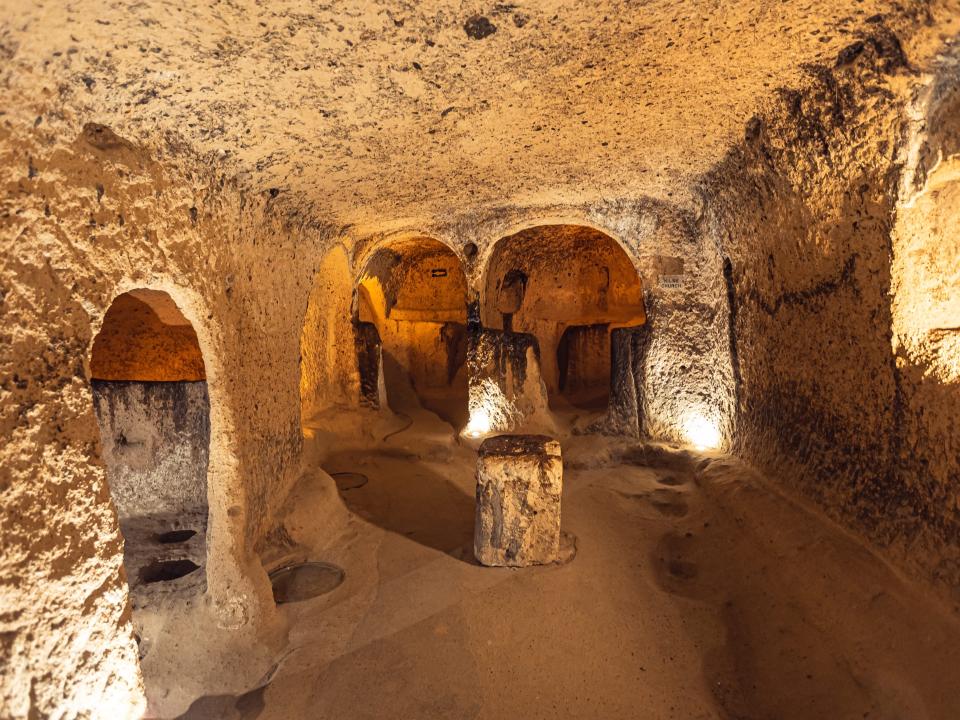In a small town in the heart of Cappadocia, Turkey, an unassuming renovation led to a discovery that would rewrite local history. A local man, while remodeling the basement of his home, accidentally knocked down a wall and found a narrow gap that revealed a hidden passage. Curious, he cleared away the debris and followed the tunnel, only to stumble upon an entire abandoned underground city that had once sheltered as many as 20,000 people. This astonishing site, known as Derinkuyu, extends 280 feet beneath the surface and is a labyrinth of tunnels, rooms, and passageways that tell the story of an ancient civilization. Over the centuries, Derinkuyu had been shrouded in mystery, its existence known only to locals who occasionally discovered secret entrances in their own homes. Now, decades after its accidental rediscovery in 1963, Derinkuyu stands as one of the most remarkable archaeological sites in the world.
The underground city of Derinkuyu is not a single, isolated chamber but a sprawling complex of 18 levels carved entirely from soft volcanic tuff—a rock formed from volcanic ash that is surprisingly easy to shape. This geological feature made it possible for ancient builders to carve out extensive living spaces beneath the earth’s surface. At its deepest point, Derinkuyu reaches 280 feet below ground, its corridors and caverns stretching out like the veins of a giant living organism. Historians believe the original construction of the city began as early as the 8th or 7th century BC, likely initiated by the Phrygians, a people known for their advanced culture and craftsmanship. Over the centuries, successive groups expanded and modified the complex, adding storage rooms, communal spaces, and religious sanctuaries. The city was designed with ingenious features: large stone doors on each level could be closed to block intruders, and sophisticated ventilation shafts ensured that fresh air circulated even in the deepest chambers. These features allowed the inhabitants to live underground for extended periods, sometimes for months at a time, as a refuge from invading forces.
For much of its history, Derinkuyu served as a sanctuary during times of war and unrest. When external threats loomed, entire families would descend into its depths, finding safety in the concealed corridors. Life in the underground city was austere yet remarkably self-sufficient. The inhabitants stored food, cultivated wine in underground cellars, pressed oil, and even maintained stables for their livestock on the upper levels, where smells would not permeate the living quarters below. In the midst of these functional spaces, there were also areas dedicated to spiritual life. Small chapels and a religious school attest to the importance of faith and learning in the community. Yet, despite the hardships of living in perpetual darkness and isolation, the people of Derinkuyu managed to thrive for centuries, until the early 20th century.
The turning point for Derinkuyu came during the turbulent period of the Greco-Turkish War in the 1920s. Faced with relentless conflict and political upheaval, the Cappadocian Greeks, who had long inhabited the underground city, were forced to flee to Greece. In their hurried departure, they left behind an entire world beneath the earth, and Derinkuyu was gradually forgotten by time. For decades, the subterranean city lay silent and hidden from the modern world, its chambers filled only with echoes of the past.
The rediscovery of Derinkuyu is as much a tale of serendipity as it is one of historical significance. In 1963, while a local man was renovating his basement, he noticed that his chickens were mysteriously disappearing. Intrigued, he investigated a gap that had opened in the wall. Upon clearing away some old plaster and debris, he uncovered a narrow tunnel that led him deep into the earth. Following the tunnel, he soon found himself standing at the entrance of a vast underground network. Unaware of the magnitude of his discovery, he had inadvertently reawakened a lost world. His find sparked the interest of archaeologists and historians, and over the following years, systematic excavations revealed the full extent of Derinkuyu’s 18 levels, its labyrinthine passages, and its myriad hidden rooms.
Today, Derinkuyu is recognized as a UNESCO World Heritage site and has become one of Turkey’s most celebrated archaeological treasures. Although only eight of its 18 levels are open to the public, each accessible section reveals the ingenuity and resourcefulness of its builders. Visitors can wander through narrow corridors that twist unpredictably, explore expansive chambers once used for communal gatherings, and even step into a small chapel where ancient rituals may have once been performed. Guided tours provide historical context, explaining how the city’s complex ventilation systems, water channels, and massive stone doors were essential to its survival. The underground network was not only a refuge from external dangers but also a self-contained urban center that supported thousands of people for centuries.
The geology of the Cappadocian region played a crucial role in the creation of Derinkuyu. The soft volcanic tuff, which blankets the landscape, allowed for extensive carving with relatively simple tools. This unique rock, when dry, is surprisingly soft, yet once exposed to the elements, it hardens into a durable material that has withstood the passage of time. The ease with which ancient builders could work this material explains why such an expansive underground city was possible. The delicate balance between natural erosion and human engineering has preserved Derinkuyu’s intricate network of tunnels and rooms, offering modern explorers a rare window into a world that once buzzed with life.
While Derinkuyu is often celebrated for its impressive scale and engineering, it is also a reminder of the ephemeral nature of human life. For centuries, the inhabitants of this hidden city managed to create a functional society underground, carving out spaces for living, working, and worshiping in an environment that would seem inhospitable by any modern standard. Yet even the most well-organized community cannot last forever. When the Cappadocian Greeks fled in the 1920s, they left behind not just buildings but also a legacy of survival and ingenuity that would eventually captivate the world.
The discovery of Derinkuyu in the 1960s transformed local folklore into international fascination. More than 600 entrances to the underground city have since been found in various homes and ruins throughout the region, suggesting that Derinkuyu was once integrated into the daily lives of the local population. These hidden doorways, often cleverly concealed within the architecture of traditional houses, serve as a constant reminder of the underground world that lies just beneath the surface. For local residents, Derinkuyu is not merely an archaeological site but a part of their collective identity—a treasure trove of history that has shaped their region’s character.
In modern times, Derinkuyu has become a major tourist attraction, drawing visitors from around the globe who come to marvel at its mysterious corridors and expansive chambers. Tourists are guided through a carefully curated section of the underground city, where knowledgeable guides recount tales of ancient invasions, ingenious defensive mechanisms, and the daily lives of the people who once called this subterranean world home. The experience is both eerie and inspiring—a journey back in time that reveals the resilience of a community that thrived in the darkness. Visitors leave with a sense of wonder and a deeper appreciation for the complexities of human history, as well as for the natural forces that allowed such an extraordinary city to exist.
Scholars have long debated the origins and purpose of Derinkuyu. Some suggest that it served primarily as a refuge during times of war, while others argue that it was an integral part of a sophisticated underground urban system that supported a vibrant community. Evidence from excavations indicates that the city was well-equipped with storage rooms, workshops, and even areas for livestock. The upper levels likely housed temporary shelters and communal gathering spaces, while the lower levels were reserved for more permanent structures, such as kitchens, religious sites, and storage facilities for food and water. These insights have helped historians piece together a picture of life in ancient Cappadocia—a life that was as challenging as it was inventive.
The cultural impact of Derinkuyu extends far beyond its physical presence. For the people of Cappadocia, the underground city symbolizes the region’s rich heritage and the remarkable ability of its inhabitants to adapt to an often-hostile environment. Festivals, local art, and even modern architectural designs draw inspiration from the intricate carvings and ingenious solutions found within Derinkuyu. It has become a powerful emblem of survival and creativity, a reminder that even in the face of adversity, humanity can find a way to endure and flourish.
Today, Derinkuyu stands as one of the world’s most extraordinary archaeological sites—a place where the past and present converge in a complex dance of history and mystery. Its vast network of tunnels and chambers, carved out of soft volcanic rock and reinforced by centuries of human effort, continues to intrigue scientists, historians, and tourists alike. The underground city is not merely a relic of ancient times; it is a living monument to the ingenuity and perseverance of those who built it. As researchers continue to study its depths and uncover new secrets, Derinkuyu promises to shed further light on the history of human civilization in this unique part of the world.
The tale of the man who inadvertently uncovered Derinkuyu by knocking down a wall in his basement is a testament to the unexpected ways in which history can be revealed. What began as a mundane home renovation quickly turned into an extraordinary archaeological discovery, opening up a hidden world that had lain dormant for centuries. This serendipitous event has not only enriched the historical record of Cappadocia but has also sparked renewed interest in other underground cities that may still be waiting to be discovered. For the modern world, Derinkuyu serves as both a warning and an inspiration—a reminder that the earth holds secrets that defy our expectations, and that with persistence, curiosity, and a bit of luck, even the most forgotten corners of history can be brought back to light.
As the underground city of Derinkuyu is now open to visitors as part of a UNESCO World Heritage site, it continues to captivate the imagination of those who journey into its depths. Each passage, chamber, and carved doorway offers a glimpse into a lost world—a world where thousands of people once found refuge, built communities, and created a legacy that endures to this day. The story of Derinkuyu is a chronicle of human resilience, ingenuity, and the eternal quest to find shelter and meaning in a turbulent world. It reminds us that even the most inaccessible places can hold stories of wonder, and that sometimes, the key to our future lies hidden beneath the surface of our past.
















0 commentaires: